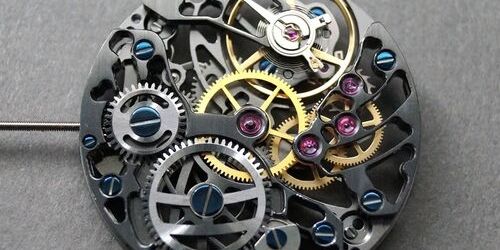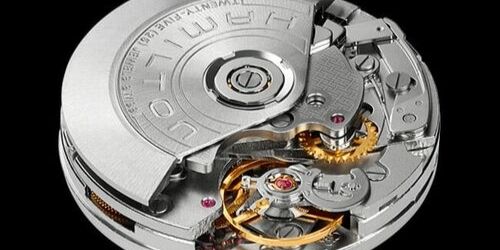Type Of Watch Movements: How They Work
What types of watch movement are there? How do watches work? Whether you are a watch connoisseurs, or just an occasional watch admirer, the workings of a watch can often seem like a bit of a mystery. However, most of us understand that the internal workings of a watch can impact function and quality.
The movement also known as a caliber is the mechanism that powers the watch. This core element drives the hands on the watch face and is involved in different watch functions (known as complications) such as stopwatches, calendar, dual time zone and chronograph,
The movement is where a watchmaker will spend time diligently crafting a mechanism that will elevate the watch from mediocre to masterpiece.
So while a nice looking watch is still a nice looking watch, it really is the insides that count. The movements are split three categories;
- Mechanical – enables the second hand to move in a sweeping fluid motion. For this watch to function it needs manual winding.
- Quartz – powered by a battery, this movement allows the second hand to move in individual ticks.
- Automatic – It is the kinetic energy transferred from the watch wearer’s wrist that automatically drives this watch mechanism
But there’s more. Below we delve deeper into types of watch movements, so you will know exactly what makes your watch tick.
How do mechanical watches work?
When it comes to luxury watch brands, mechanical movements are often the preferred choice. This is because mechanical watches lend themselves well to high levels of craftsmanship.
These types of watch movements contain minute components that work together to power the timepiece.
Mechanical watches have not changed much over the centuries; however technological advancements means there is far more precision involved allowing for more attention to detail.
The mechanical watch movement works by:
- Mechanical movements use the energy from a wound main spring to power the watch, as opposed to a battery – like a quartz watch (for example). This type of watch movement is driven by a type of spring called the mainspring.
- For this watch movement to function, it needs to be wound up periodically.
- Once this movement is wound, a force is relayed through a sequence of gears. It is this action that powers the balance wheel, which is a wheel that swings back and forth at a constant rate.
- Then the escapement release kicks in which moves the wheels forward a fraction with every oscillation from the balance wheel.
- It is all this that moves the watch hands forward at a constant rate.
Advantages of mechanical watches
- Batteries: A major advantage of a mechanical watch is not having to use batteries This means wherever you are whatever you are doing, you don’t need to worry that your watch will stop because of a dead battery. So even if your watch is stored away for a long period of time, all it will need is a wind of the mechanism to get it going.
- Longevity: As long as it is well crafted, and well cared for, a mechanical watch can last a lifetime.
- Satisfaction: There are those that enjoy the daily or weekly ritual of rewinding a manual wristwatch.
- Aesthetics: Because craftsmanship often goes hand in hand with a mechanical timepiece, many have clear sapphire casing to show all the intricate rotations and oscillations of the wheels and gears, which not only is fascinating but very attractive to look at.
How does a quartz movement work?
The world’s first quartz watch was unveiled to the world in December 1969 by Seiko, the Japanese watchmakers. Since then this type of movement has been a popular choice, as many watch companies flooded the market with their own versions of quartz timepieces.
Quartz watches work in a very different way to other watches. While they have gears that count the seconds, minutes, and hours, these are regulated by minute quartz crystals. It is these quartz crystals that move the balance wheel.
Quartz is one of most common minerals on Earth. It is composed from a chemical compound called silicon dioxide, which can be found in rocks or sand. What’s fascinating about quartz is that it’s piezoelectric, which means if you squeeze a quartz crystal it will generate a small amount of electric voltage.
The quartz watch movement works by:
- Inside a quartz watch, the battery will transmit electricity to the quartz crystal via an electronic
- The quartz crystal oscillates at a precise frequency of 32768 times every second.
- The circuit within the movement then counts the number of oscillations and generates regular electric pulses, one per second.
- It’s these pulses that can power an LCD display or turn the gears that move the watch hands.
Advantages of quartz watches
Low Maintenance: Less moving parts and a battery means quartz movement watches require less maintenance.
Precision: A quartz clock tells the time just as well when you’re climbing Mount Everest as it does when you’re at sea.
Durable: With less moving parts, these types of watch movements should fairly long lasting.
Cost effective: Less watchmaking hours that go into quartz watches, in comparison to say a mechanical watch or an automatic. This means that quartz watches are lower in cost to buy.
How do automatic watches work
The automatic watch movement is often called “self-winding” and is a type of mechanical movement. While there were reports of a self-winding watch as far back as 1773, the first credible example was made by the Swiss watchmaker Abraham-Louis Perrelet in 1777. Back then, the Geneva Society of Arts, reported that it took the watch 15 minutes walking to fully wind.
The term “self-winding” refers to how the watch winds itself, the automatic watch works by:
A metal weight called a rotor which is connected to movement Since it is connected to the movement, the rotator and can rotate freely. With each movement of the wrist, the rotor spins, transferring energy and automatically winding the mainspring.
The automatic watch movement works by:
- Weights within the watch that oscillate putting tension on the mainspring through the motions of the wearer’s arm
- With every movement of the wrist, the rotor spins and while doing so transmits energy to the mainspring.
- Because of this transferring of energy, the mainspring automatically winds.
Advantages of an automatic watch
- No Batteries required: This is a major plus point for getting an automatic watch. With no batteries the dangers of battery fluid leaking are eliminated, it is this corrosive fluid that causes the internal metal parts to rust.
- Low maintenance: While some enjoy the daily ritual winding up a watch, many do not want the hassle of remembering to do this. So in these cases, an automatic watch is ideal.
- Works with you: The more you wear your automatic watch, the longer it functions.
- In comparison to a standard quartz watch, a self-winding time piece can last decades, sometimes even longer.
It should be noted that automatic watches tend to be thicker than mechanical watches; this is due to the additional rotors. If you want to assess the quality of an automatic watch, feel the weight of it on your palm, it should feel somewhat hefty.










